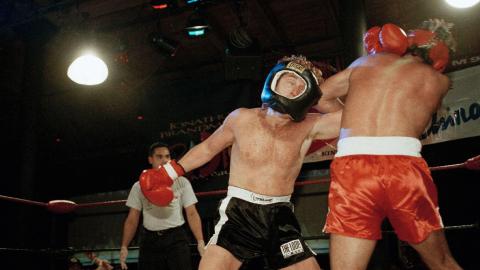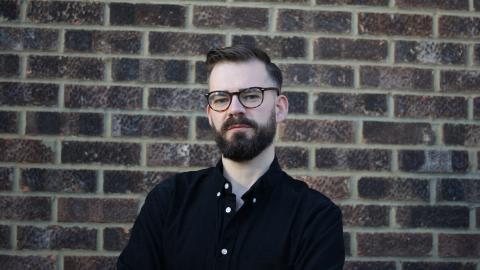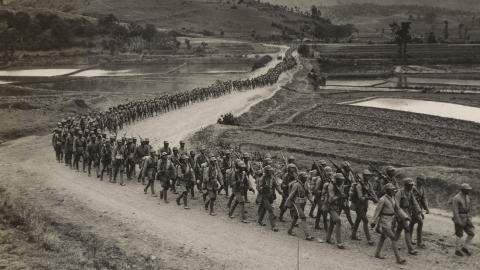The Boy Who Stood Up To The Nazis
'Since the conquest of Poland, three hundred thousand Jews have been murdered in this country in the most bestial way. A crime that is unparalleled in the whole of history.' - Hans Scholl
In 1937, 19-year-old Hans Scholl was the quintessential Hitler Youth leader – blond, tall and athletic, the epitome of Hitler’s so-called ‘master race’. But after experiencing persecution himself at the hands of the Gestapo, Scholl embarked on an audacious campaign to influence the hearts and minds of ordinary Germans against the brutal Nazi regime. The campaign which became known as the White Rose resistance movement required bravery in the face of a Nazi party police state which rarely spared political dissenters from interrogation, torture and incarceration.
Today members of the resistance group have become German national heroes celebrating the courage of a few young individuals, most of whom were barely past their teens and who, like the young Hans Scholl paid the ultimate price of fighting for freedom with their lives.
Seventy-five years have passed since three German students including Hans Scholl and his sister Sophie were executed for leading the resistance movement which began in Munich on the 27th June 1942. The launch of the campaign was during a critical period of WW2 as the German population was becoming aware of the losses of war and damages to the country. To counter potential rebellious acts the Gestapo ruthlessly suppressed public unrest and disobedience as a growing number of citizens, including students like Hans Scholl and his sister Sophie recognised the increasing futility of conflict led by a ‘megalomaniac’ and fearing irreversible consequences for Germany and its people.
The White Rose resistance movement consisted of a nucleus of students from the University of Munich headed by Hans and Sophie. Ironically the two close siblings as young teenagers willingly joined the Hitler Youth and Bund Deutscher Madel (League of German Girls) parties respectively. The purpose of both these organisations was to indoctrinate young people within the National Socialist belief system and to train them for their roles in a new militarised German society. Hans, his sister Sophie and their elder sibling Inge Scholl’s active participation in such parties dismayed their liberal and free-thinking parents who were involved in politics at the time and critical of the Nazi regime.
Turning Point
It was while the young Hans was a member of a forbidden Youth Movement organisation that he was accused of transgressing the German anti-homosexuality law after having a same-sex relationship with a fellow party member when Hans was only sixteen years old. It has been argued that the experience of being persecuted for being gay led both Hans and his sister Sophie to identify with the victims of Hitler’s Nazi state and sealed their transformation from Hitler Youth participants to passionate opponents of the Nazi regime.
The Seeds of Rebellion
Members of the White Rose resistance movement totalling less than twenty members, headed by Hans and Sophie Scholl, comprised of a nucleus cell at the centre of a network of young, mainly middle-class student collaborators.
The core players included fellow student Alexander Schmorrell who happened to be a childhood friend of Christoph Probst, a student of medicine, who came into the movement late and wrote some of the texts for the controversial leaflets. Another student Willi Graff differed from many of his fellow White Rose comrades as he had refused to associate with the Hitler Youth. One survivor of the movement after the war had ended was Liselotte Furst-Ramdohr who had been made a widow at 29 after her husband was killed on the Russian front. Decades later she recounted that the group couldn’t understand how the German people had been so easily led into supporting the Nazi party and its ideology. The leaflets were designed to wake up what the resistance movement believed were ‘hoodwinked’ citizens seduced by a ‘megalomaniac’.
The motivations behind young Hans Scholl’s setting up of such a dangerous resistance group didn’t arise solely from ideology or even his time spent in prison for being gay, but like many other White Rose members were inspired by their traumatic experiences at the Eastern Front. It was there they were awakened to the brutalities carried out by the Nazi regime against the Jewish population which included mass murder in Poland and Russia.
Distributing Leaflets
Hans and his sister Sophie aimed to convince Germany’s intelligentsia about both the reality of Hitler’s murderous regime and the futility of war through a series of pamphlets – six in total - that would be distributed through major cities and towns such as Munich, Vienna, Hamburg, Freiburg and Berlin. The pamphlets were left in public phone booths, mailed to various influential individuals including professors and taken by courier to universities. It was a dangerous path to undertake setting up an underground network of fellow students in these cities where White Rose members would print, transport and mail mimeographed leaflets that denounced the Nazi regime. A total of 15,000 copies were made that openly denounced the persecution and mass murder of the Jews.
The operation mainly involved distributing leaflets to addresses in the Munich area and other cities selected at random from the phone book. In order to prevent any trace back, they had to be delivered by hand through trusted couriers. Apart from the distribution of leaflets the movement’s tactics also included making tin templates to create stencils for a graffiti campaign. Furst-Ramdohr recalled herself in interviews making stencils in her flat saying ‘Down with Hitler’, which the White Rose members then graffitied as a slogan on walls across Munich and other cities.
Betrayal and Arrests
Through illegally writing, printing and distributing the political pamphlets, Hans and his young collaborators revealed their opposition to German militarism and anti-Semitism in a bold daring campaign that had brought the movement to the attention of the Gestapo.
Despite the military precision of the movement’s operations around the country, it was one careless spontaneous act that was its undoing on the 18th February 1943 when Hans and Sophie showered their fellow students in the atrium of Munich University with opposition leaflets.
Soon afterwards other members of the White Rose movement were arrested including Furst-Ramdohr who spent a month in Gestapo custody but was eventually released due to what she believes was her ‘war widow’ status. The others including Hans and his sister were not so lucky.
Executions & Legacies
The People’s Court had been established on April 24th, 1934 to try prisoners who were deemed to be guilty of political offences against the Nazi state. Designated as show trials to humiliate the victims and send a harsh message to anyone thinking of similar protests against Hitler and the Nazi regime it was unlikely the trials against Hans, Sophie and fellow White Rose member Christoph Probst would result in anything less than guilty verdicts and death sentences for all.
Only four days after Hans and Sophie’s arrest at Munich University they were found guilty and executed by guillotine on the same day. Sophie was just 21 and Hans 24. It is alleged that Hans’ last words were – ‘Long Live Freedom’
The final White Rose leaflet was smuggled out of Germany and intercepted by Allied forces with the result that in the autumn of 1943 millions of copies of the pamphlet, re-titled ‘The Manifesto of the Students of Munich’ were dropped on German cities. Despite the brave and courageous efforts of the young members of the White Rose movement, the resistance campaign did not provoke any active opposition to the Nazi regime from the German populace at the time. However, the movement’s legacy as an inspiring narrative is lauded around the world today and has come to represent selfless opposition to tyranny in all forms, particularly that which is fuelled by prejudice and racism.
As a tribute to Hans and his White Rose movement the square where the central hall of Munich University is located and scene of both Hans and his sister Sophie’s arrest by the Gestapo is now known as Geschwister-Scholl-Platz.
















